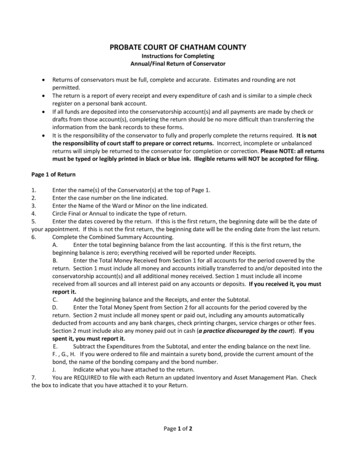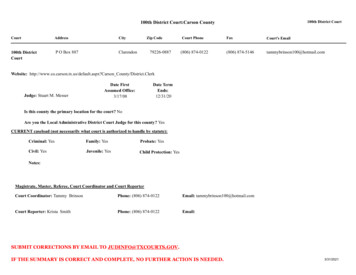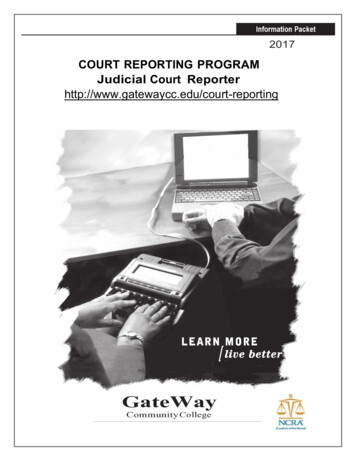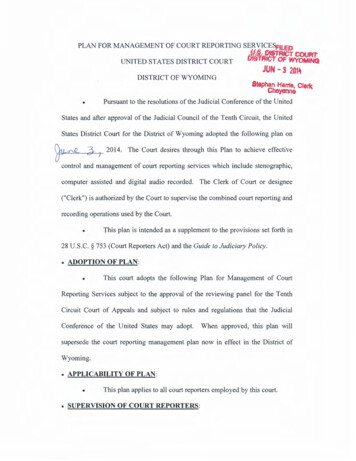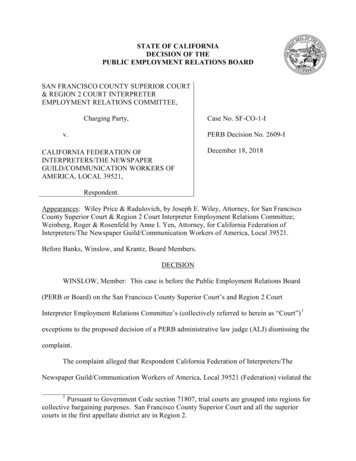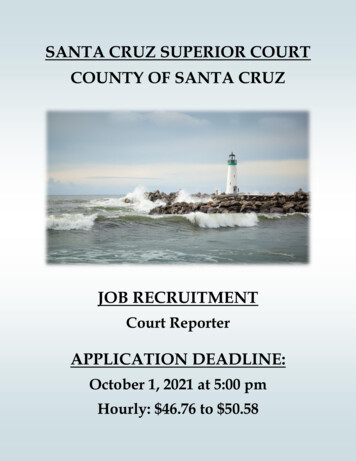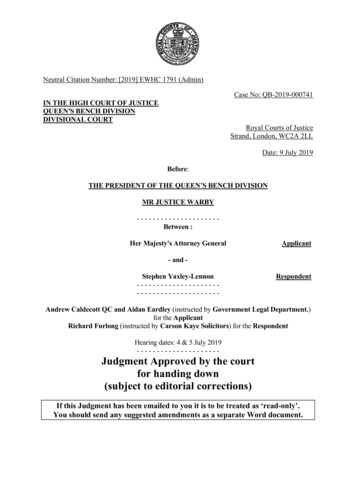
Transcription
Neutral Citation Number: [2019] EWHC 1791 (Admin)Case No: QB-2019-000741IN THE HIGH COURT OF JUSTICEQUEEN'S BENCH DIVISIONDIVISIONAL COURTRoyal Courts of JusticeStrand, London, WC2A 2LLDate: 9 July 2019Before:THE PRESIDENT OF THE QUEEN’S BENCH DIVISIONMR JUSTICE WARBY--------------------Between :Her Majesty's Attorney GeneralApplicant- and Stephen ----RespondentAndrew Caldecott QC and Aidan Eardley (instructed by Government Legal Department.)for the ApplicantRichard Furlong (instructed by Carson Kaye Solicitors) for the RespondentHearing dates: 4 & 5 July 2019---------------------Judgment Approved by the courtfor handing down(subject to editorial corrections)If this Judgment has been emailed to you it is to be treated as ‘read-only’.You should send any suggested amendments as a separate Word document.
High Court Unapproved Judgment:No permission is granted to copy or use in courtAG v Yaxley-Lennon [2019] EWHC 1791 (Admin)DAME VICTORIA SHARP:Introduction1.This is the judgment of the Court on an application by Her Majesty’s Attorney Generalfor an order committing the respondent to prison for contempt of court.2.The respondent is Stephen Yaxley-Lennon, also known as Tommy Robinson. Theapplication arises from what he did and said outside the Crown Court at Leeds on themorning of Friday 25 May 2018, when the jury was in retirement at the end of R vAkhtar, a long trial in which a number of men were accused of sexual offences againstwomen and girls. The focus of the application is on the respondent’s live-streaming ofvideo of what he did and said, to an online audience via his Facebook page, which hadbeen liked or followed by some 1.2 million people at the time.3.In summary, the Attorney General alleges that the respondent’s conduct amounted tocontempt of court in three different respects. First, the online publication involved abreach of a reporting restriction order (“the RRO”) that had been imposed under s 4(2)of the Contempt of Court Act 1981, and which prohibited any reporting of the Akhtartrial until after the conclusion of that trial and all related trials. Secondly, the AttorneyGeneral alleges that the content of what was published gave rise to a substantial riskthat the course of justice in the Akhtar case would be seriously impeded, therebyamounting to a breach of the rule of contempt law known as “the strict liability rule”.Thirdly, it is alleged that by confronting some of the defendants as they arrived at Court,doing so aggressively, and openly filming the process, the respondent interfered withthe due administration of justice. Contempt of court is quasi-criminal in nature, so theonus is on the Attorney General to prove his case so that we are sure.4.Permission to bring this application was granted by this Court after a hearing on 14May 2019. We heard the substantive application on 4 and 5 July 2019, and on Friday 5July 2019, we announced our decision in the following terms:“The purpose of the law of contempt of court is to protect theintegrity of legal proceedings, the administration of justice, andultimately the rule of law, which is vital to the protection of therights of every citizen.Our conclusions are as follows. The respondent committed acontempt of court on 25 May 2018 in three respects: first, bybreaching a reporting restriction imposed under s 4(2) of theContempt of Court Act 1981, in the case of R v Akhtar; secondly,by live streaming a video from outside the public entrance to thecourt, the content of which gave rise to a substantial risk that thecourse of justice in that case would be seriously impeded; andthirdly, by aggressively confronting and filming some of thedefendants in that case as they arrived at court, thereby directlyinterfering with the course of justice.In our judgment, the respondent’s conduct in each of thoserespects amounted to a serious interference with theadministration of justice.”Draft 9 July 2019 10:45Page 2
High Court Unapproved Judgment:No permission is granted to copy or use in court5.AG v Yaxley-Lennon [2019] EWHC 1791 (Admin)These are our reasons.The history6.Much of this has been set out in a judgment of the Court of Appeal [2018] EWCA Crim1856 [2018] 1 WLR 5400.Huddersfield7.In 2017, a total of 29 individuals were charged with involvement in the sexualexploitation of young women and girls in the Huddersfield area. On 12 April 2017,there was a hearing at Huddersfield Magistrates Court, at which the defendants weresent for trial in the Crown Court. The respondent attended, and took part in videorecorded reporting. There was other reporting of these proceedings.Canterbury8.On 8 May 2017, the respondent attended the Crown Court at Canterbury, at a time whena jury had been sent out to consider their verdicts at the end of a trial (unrelated to theHuddersfield charges) in which four defendants were accused of rape. The respondentfilmed himself on the steps of the court building and inside the building, including twopieces to camera in which he described the trial as involving “Muslim child rapists”.He then published the footage on the internet. At a hearing on 22 May 2017, when hewas represented by Leading and Junior Counsel, the respondent admitted contempt byfilming in the precincts of the court. For this contempt, he was committed to a term ofthree months’ imprisonment, suspended for 18 months.Leeds9.In the meantime, on 11 May 2017, there was a directions hearing before HHJ MarsonQC in the Crown Court at Leeds, when the Judge made orders in respect of theHuddersfield charges. He directed that those charges should be tried in a series of threetrials in Leeds, commencing in January, April and September 2018. The first case wascalled Dhaliwal and others. The Akhtar case was the second of the three. Theseproceedings were reported in the Huddersfield Examiner and other media, includingthe BBC.10.On 19 March 2018, in the Crown Court at Leeds, the RRO was made by HHJ MarsonQC. It was headed, in capitals, “Notice to the Press – Reporting Restriction” and“Postponement Order”. It was made in the Akhtar proceedings, and provided that “Thepublication of any report of these proceedings shall be postponed until after theconclusion of this trial and all related trials.” The statutory provision under which theorder was made was identified. The purpose of the order was specified: “Since itappears to be necessary for avoiding a substantial risk of prejudice to the administrationof justice in these proceedings”. That is one of the statutory bases for making such anorder, and although the grounds were imperfectly stated, no challenge was made to theRRO or the Judge’s decision to make it until the skeleton argument for the presenthearing.11.On 16 April 2018, the Akhtar trial began, before HHJ Marson QC and a jury. Therewere originally 10 defendants. On Thursday 24 May 2018, the jury were sent out toDraft 9 July 2019 10:45Page 3
High Court Unapproved Judgment:No permission is granted to copy or use in courtAG v Yaxley-Lennon [2019] EWHC 1791 (Admin)consider their verdicts. By this time there were 9 remaining defendants. On the morningof Friday 25 May 2018, the respondent attended the Court. He spoke to Court staff. Hewas filmed speaking about the case, and speaking to some of the defendants. The videowas live-streamed. Later that same day, the respondent came before HHJ Marsonaccused of contempt of Court. The Judge adopted a summary procedure. Therespondent took advice from Counsel, and admitted contempt. Counsel mitigated onhis behalf. It was accepted that “he was aware there was a reporting restriction”, butCounsel submitted that there was mitigation that would “allow [the Judge] to draw backfrom the imposition of an immediate custodial sentence.” The Judge was not persuaded,and committed him to prison for 10 months, simultaneously activating the suspendedorder imposed at Canterbury, which was made consecutive. The respondent wastherefore committed to prison for a period of 13 months. An RRO was imposed inrespect of those events, pursuant to s 4(2). This was later lifted.12.The jury deliberated for the rest of 25 May 2018, and were then sent away until thefollowing Tuesday, 29 May. On that day, Counsel for two of the defendants appliedunsuccessfully for the discharge of the jury, relying among other things on the way inwhich the respondent had confronted the defendants and the allegedly prejudicial natureof what had been said. On Friday 1 June 2018 there was a large demonstration by theEnglish Defence League outside the Crown Court at Leeds, protesting at therespondent’s arrest and imprisonment. One of the defendants in the Akhtar trial, SajidHussain, absconded. His Counsel had expressed concern on his behalf about thedemonstration, which had been advertised in advance. On Monday 4 June 2018, a freshapplication to discharge was made, based on the effects of the demonstrations. This wasrejected. On Tuesday 5 June 2018, the jury returned their verdicts, finding each of theremaining defendants guilty on all counts that had been left to the jury for decision.London: Court of Appeal13.The respondent appealed to the Court of Appeal (Criminal Division) (“CACD”) butonly against the sentence imposed by the Crown Court at Leeds. The Criminal AppealOffice, on reviewing the papers, identified some procedural flaws in the process inLeeds, which prompted an appeal against the finding of contempt. The respondent alsosought to appeal out of time against the Canterbury committal and sentence.14.His case was heard on 18 July 2018. On 1 August 2018, the Court handed down thejudgment to which we have referred. It refused to extend time to appeal against thedecisions made at Canterbury, and quashed the committal order made at Leeds. Inoutline, the Court’s reasons were that (i) it had been inappropriate to deal with thematter summarily; (ii) although it was tolerably clear that the nub of the allegation wasbreach of the RRO, there had been no clear statement of the conduct alleged to representsuch a breach; (iii) the Judge’s reasoning did not make clear what he considered to bea breach, and relied on conduct which – if it was contempt - could not have amountedto breach of the RRO; and (iv) the haste with which the process was conducted hadcurtailed Counsel’s ability to put forward full mitigation on the respondent’s behalf: see[77]. The respondent, who had by this time spent some 10 weeks in custody, wasreleased on bail.15.The CACD remitted the matter to the Crown Court, directing that it be heard before theRecorder of London at the Central Criminal Court as soon as reasonably possible. TheCACD highlighted the requirements of clarity and particularity. In the context of theDraft 9 July 2019 10:45Page 4
High Court Unapproved Judgment:No permission is granted to copy or use in courtAG v Yaxley-Lennon [2019] EWHC 1791 (Admin)RRO, it identified the need to take “proper steps to set out the offending conduct, byreference to the video in question”. It also noted that other forms of contempt might bealleged, observing that “outside references to the [RRO] there were aspects of the videowhich [HHJ Marson] considered amounted to criminal contempt ” It was recognisedthat the case needed to be “presented by someone other than a judge.”16.The procedure identified by the CACD to achieve these objectives was the oneprescribed by Part 48 of the Criminal Procedure Rules, coupled with an invitation tothe Attorney General to nominate an advocate to appear at the fresh hearing.17.The relevant provisions of Part 48 are set out in the CACD judgment at [41]. Theyenvisage an “inquiry”, which may be conducted “there and then” or postponed. Theprocedure at Leeds had involved an inquiry there and then. The CACD envisaged afresh hearing that was postponed, thus requiring the Court, as a first step, to “arrangefor the preparation of a written statement containing such particulars of the conduct inquestion as to make clear what the respondent appears to have done”: r 48.7(2).Thereafter, the procedure laid down by Part 48 is a relatively simple one. The Courtmust identify the procedure to be adopted and inform the respondent. If the respondentadmits the conduct, the Court need not receive evidence. If the respondent does notadmit the conduct, the Court must consider any statement under r 48.7, any otherevidence, and any representations by the respondent.18.This procedure is suitable for relatively simple cases, but not for those that require theresolution of substantial factual issues as, in the event, proved to be the position in thiscase. Appointments by the Attorney General of an advocate to the Court are governedby a Memorandum dated 19 December 2001, the effect of which is to restrict theadvocate to providing assistance on the relevant law and application to the facts. Theadvocate is not authorised to carry out factual investigations, lead evidence, or crossexamine witnesses.London: the Central Criminal Court19.It started in satisfactory way. Counsel was appointed by the Attorney General on 24August 2018, and thereafter produced particulars, specifying the alleged contempts.The allegations were of breach of the RRO, and breach of the strict liability rule. In ourjudgment, they were clear and sufficient. However, on 22 October 2018, the respondentserved a witness statement which made clear, for the first time, that there weresignificant issues of fact between the parties, which would require resolution. Heclaimed to have made enquiries at court and online about the existence and content ofan RRO. That account called for an evidential investigation which was outside thescope of the role assigned to the advocate to the Court, and it would have been quiteinappropriate for the Recorder of London to undertake it. Accordingly, on 23 October2018, the Recorder held that the matter could not fairly be disposed of under the Part48 procedure. Instead, he referred the matter to the Attorney General, to considerwhether the Attorney General should bring proceedings of an adversarial nature, inwhich Counsel for the Attorney General could lead evidence and cross-examinewitnesses. On 5 November 2018, the respondent was released from bail.The CACD againDraft 9 July 2019 10:45Page 5
High Court Unapproved Judgment:No permission is granted to copy or use in courtAG v Yaxley-Lennon [2019] EWHC 1791 (Admin)20.On 21 November 2018, a single Judge of the CACD considered an application by FaisalNadeem, one of the defendants in the Akhtar case, for permission to appeal againstconviction. The application was based principally on the proposition that Nadeem’strial had been prejudiced by (a) the respondent’s activities in streaming video ofNadeem outside court, appearing to react aggressively to provocation by therespondent, and in which the respondent referred to another sexually related charge onwhich Nadeem was to be tried and (b) protests following the respondent’simprisonment by HHJ Marson.21.The single Judge dismissed the application. He rejected the contention that the jurywould have become aware of the video and been prejudiced by it as “a whollyspeculative ground of appeal which has no evidential basis”. He pointed out that thejury had been repeatedly told that they should not carry out researches, should try thecase on the evidence, and must tell the Judge if any fellow juror disobeyed thoseinstructions. He observed that there was no evidence that any juror did disobey thoseinstructions, or felt unable to decide the case on the evidence accordance with his or heroath. The protests had been directed at the Judge not the jury, and there was no reasonto believe that they put the jury under pressure.The present proceedings22.Following correspondence, in the course of which the respondent’s solicitors maderepresentations as to why further proceedings should not be instituted, the AttorneyGeneral brought this application. He did so by means of a Claim Form under Part 8 ofthe Civil Procedure Rules, invoking the provisions of Part 81 which governs“Applications and proceedings in relation to contempt of court”. Details of claimaccompanied the Claim Form. These began by explaining that the Attorney Generalsought permission to apply to a Divisional Court of the Queen’s Bench Division “foran order of committal and/or such other order as may seem just for his contempt ofcourt”, details of which were set out in written grounds.The permission hearing23.We heard the permission application on 14 May 2019, at the Central Criminal Court.Three main issues arose for our decision: was permission required for all three limbs ofthe Attorney General’s application; what were the threshold tests to be applied andshould permission be granted? We concluded that permission was required for eachlimb of the application; that the Court should examine each limb separately and givepermission to proceed if, and only if, it was satisfied that the application disclosed areasonable basis for seeking committal, which it was in the public interest to pursue andthat these threshold requirements were met. We announced our conclusion, and grantedpermission, reserving our reasons, which we give at the end of the present judgment.Draft 9 July 2019 10:45Page 6
High Court Unapproved Judgment:No permission is granted to copy or use in courtAG v Yaxley-Lennon [2019] EWHC 1791 (Admin)The substantive hearing24.The Attorney General’s application is supported by an affidavit from James Jenkins,Head of Criminal Casework at the Attorney General’s Office. The respondent servedevidence before our decision on permission, on 26 April and 3 May 2019. Since ourgrant of permission, he has served a further affidavit, his second. The Attorney Generalhas filed affidavits in reply from the Court Security Officer at Leeds, Anthony Walton,and the Operations Manager, Michelle Dunderdale. There is a short supplementalaffidavit from Mr Jenkins, which we gave leave to adduce. Ms Dunderdale, Mr Waltonand the respondent were cross-examined before us. During the hearing, the respondentsubmitted a further affidavit (his third), and was recalled for further cross-examinationon its contents.Legal context25.Contempt of court is principally a common law doctrine. Its purpose is to protect theintegrity of civil and criminal proceedings by imposing appropriate penalties on thosewho interfere with, obstruct, impede or prejudice the due administration of justice, orexpose the process to risk that these consequences will follow. The label “contempt ofcourt” has long been considered inappropriate. As Salmon LJ observed in Morris vCrown Office [1970] 2 QB 114, 129:“The archaic description of these proceedings as “contempt ofcourt” is in my view unfortunate and misleading. It suggests thatthey are designed to buttress the dignity of the judges and toprotect them from insult. Nothing could be further from the truth.No such protection is needed. The sole purpose of proceedingsfor contempt is to give our courts the power effectively to protectthe rights of the public by ensuring that the administration ofjustice shall not be obstructed or prevented: Skipworth’s Case,L.R. 9 Q.B. 230 and Rex v Davies [1906] 1 KB 32. This powerto commit for what is inappropriately called “contempt of court”is sui generis and has from time immemorial reposed in the judgefor the protection of the public.”A similar point was made by Lord Cross of Chelsea in Attorney General v TimesNewspapers Ltd [1974] AC 273, when he suggested (at 322) that the name “contemptof court” had authoritarian overtones which might tend to predispose people in favourof the alleged offender, when in truth “the administration of justice is something whichall citizens, whether on the left or the right or in the centre, should be anxious tosafeguard”.26.The law of contempt has been supplemented and shaped by statute. Four aspects of thelaw are relevant in this case. The first is interference with parties on their way to andfrom court. It is well-established that this may amount to contempt at common law.The Court of Appeal summarised the principles and their rationale in R v Runting (1989)89 Cr. App. R. 243, 245:“ the law insists that a defendant and witnesses, and indeedanyone else who has a duty to perform at a Court, whether in acriminal trial or in a civil trial, is entitled to go to and from theDraft 9 July 2019 10:45Page 7
High Court Unapproved Judgment:No permission is granted to copy or use in courtAG v Yaxley-Lennon [2019] EWHC 1791 (Admin)Court, that is between his home and the Court, whether on footor otherwise, without being molested or assaulted or threatenedwith molestation.There are two reasons for that, it seems to this Court. The firstis, there must be nothing to create in the minds of such personsany fear such as to make them less likely to wish to come toCourt to carry out their proper functions. The second reason,which is perhaps more difficult to put adequately into words, isthis: that the authority and dignity of the Court require that thosewho attend the Court to carry out their duties should be allowedto do so without let or hindrance, and again without fear ofmolestation.”27.Secondly, there is the creation and publication of images of people in the court, thecourt building, or in its precincts. Since 1925, this has been regulated by statute. TheCriminal Justice Act 1925 s 41(1) provides, in its amended form, as follows:“41.— Prohibition on taking photographs, &c., in court.(1) No person shall—(a) take or attempt to take in any court any photograph, orwith a view to publication make or attempt to make inany court any portrait or sketch, of any person, being ajudge of the court or a juror or a witness in or a party toany proceedings before the court, whether civil orcriminal; or(b) publish any photograph, portrait or sketch taken ormade in contravention of the foregoing provisions ofthis section or any reproduction thereof; (2) For the purposes of this section— (c)a photograph, portrait or sketch shall be deemed to bea photograph, portrait or sketch taken or made in courtif it is taken or made in the court-room or in the buildingor in the precincts of the building in which the court isheld, or if it is a photograph, portrait or sketch taken ormade of the person while he is entering or leaving thecourt-room or any such building or precincts asaforesaid.”We have emphasised the wording that is of particular relevance to the present case. Itis generally considered that someone who records moving images “take[s] . aphotograph” within the meaning of these provisions: see Arlidge Eady & Smith onContempt, 5th ed, para 10-216. This is a summary-only offence, carrying a maximumpenalty of a fine at Level 3 on the standard scale. It is however clear law that acts whichcontravene s 41 can, in appropriate cases, amount to contempt of court, exposing thewrongdoer to the more severe sanctions available in that jurisdiction, includingcommittal: see Solicitor General v Cox [2016] 2 Cr. App. R. 15. Given the terms of s41(2)(c), there is therefore a potential for overlap between this and the first category.Draft 9 July 2019 10:45Page 8
High Court Unapproved Judgment:No permission is granted to copy or use in court28.AG v Yaxley-Lennon [2019] EWHC 1791 (Admin)Thirdly, there is contempt by publication which tends to interfere with theadministration of justice in particular legal proceedings. The common law in thisrespect imposes strict liability, but is modified and controlled by the Contempt of CourtAct 1981. Relevant provisions are contained in ss 1 and 2:“1. The strict liability rule.In this Act “the strict liability rule” means the rule of lawwhereby conduct may be treated as a contempt of court astending to interfere with the course of justice in particular legalproceedings regardless of intent to do so.2. — Limitation of scope of strict liability.(1) The strict liability rule applies only in relation topublications, and for this purpose “publication” includesany speech, writing, programme included in a cableprogramme service or other communication in whateverform, which is addressed to the public at large or any sectionof the public.(2) The strict liability rule applies only to a publication whichcreates a substantial risk that the course of justice in theproceedings in question will be seriously impeded orprejudiced.(3) The strict liability rule applies to a publication only if theproceedings in question are active within the meaning of thissection at the time of the publication.(4) Schedule 1 applies for determining the times at whichproceedings are to be treated as active within the meaning ofthis section. ”The word “serious” is an ordinary English word, which does not require furtherdefinition; and a risk is “substantial” within the meaning of that sub-section if is “morethan remote” or “not merely minimal”: Attorney General v English [1983] 1 AC 116,142 (Lord Diplock). By Schedule 1, criminal proceedings are “active” for the purposesof s 2(3) from the time of arrest. They certainly remain active when a jury is inretirement, considering its verdicts.29.The fourth relevant aspect of the law of contempt is breach of an RRO imposed unders 4 of the 1981 Act. That section provides:“4. — Contemporary reports of proceedings.(1) Subject to this section a person is not guilty of contempt ofcourt under the strict liability rule in respect of a fair andaccurate report of legal proceedings held in public, publishedcontemporaneously and in good faith.Draft 9 July 2019 10:45Page 9
High Court Unapproved Judgment:No permission is granted to copy or use in courtAG v Yaxley-Lennon [2019] EWHC 1791 (Admin)(2) In any such proceedings the court may, where it appears tobe necessary for avoiding a substantial risk of prejudice tothe administration of justice in those proceedings, or in anyother proceedings pending or imminent, order that thepublication of any report of the proceedings, or any part ofthe proceedings, be postponed for such period as the courtthinks necessary for that purpose.”An order under s 4(2) cannot prohibit reporting altogether; it can only postpone it forsuch period as the Court thinks necessary to avoid the substantial risk of prejudice thathas been identified. These powers are often used where a series of inter-related trialstakes place, to avoid earlier trials infecting later ones. The 1981 Act does not provide,here or elsewhere, that the publication of a report in breach of an RRO imposed unders 4(2) amounts to contempt of court; but authority binding on this court holds that thesection creates a new head of contempt, separate and distinct from the strict liabilityrule: R v Horsham Justices, ex p. Farquharson [1982] QB 762 (CA).The facts30.The facts relied on by the Attorney General are set out in the affidavit evidence, muchof which is uncontested. We can outline quite shortly the evidence as to the scene, andthe sequence of relevant events on and after 25 May 2018 as we find it, identifying andresolving the modest evidential dispute that arises on this part of the case.31.The Crown Court is located in Leeds Combined Court Centre at 1 Oxford Row, whichalso houses a number of civil courts: the County Court, the Administrative Court, theBusiness and Property Courts, Family Court and the Court of Protection. There is asingle public entrance, via a revolving door, to which access is gained up five stepsfrom the street. To either side of this is an “accessibility door” for staff, and an exit. Allthese doors are unlocked at 7am, but the public are only admitted between 8:30 am and5pm. At the relevant time there was a notice on the entrance door, advertising theseopening hours. Inside the doors there is a security barrier, with arches, manned bysecurity staff.32.Immediately behind the security arches is a Reception desk, visible from the securityarea. To the right of that desk, on the wall, is the Court’s listing board and, above this,a screen known as the Xhibit screen, displaying all court listings for the day. These arevisible from the security area, though not legible from there. There are also screens withlisting information outside the courtrooms, which are further away. All these screensare turned on at 8am. The information displayed on the noticeboard and the screens isdrawn from a system called CREST. The same information is used to publish courtlistings via CourtServe, the official listing website. Responsibility for inputting listingdata into the CREST system, including reference to any RRO, lies with the Court’sdaily listing officer.33.The security area is manned from 7:00 am. The Reception desk is staffed from 8:00am, and open to the public from 9:00 am. So is the Crown Court General Office, whichis on the first floor. The Akhtar trial was in Court 12, on the third floor.34.On 25 May 2018, the respondent arrived at around 8:10 – 8:15 am, and entered thebuilding through the accessibility door. Two Court Security Officers were on duty inDraft 9 July 2019 10:45Page 10
High Court Unapproved Judgment:No permission is granted to copy or use in courtAG v Yaxley-Lennon [2019] EWHC 1791 (Admin)the foyer. Mr Walton was one of them. The respondent, who accepts that “going intothe trial I had heard there was a reporting restriction”, approached the officers. MrWalton’s evidence is that the respondent asked about a press ban in relation to acriminal trial, and whether the listing for that case was “up”. The respondent’s ownevidence is that he went up to security “to ask someone if the reporting restriction hadbeen lifted”. Mr Walton, not knowing the answer to these questions, advised therespondent to enquire at the Crown Office (meaning the Crown Court General Office),or the Court Reception when they opened. Mr Walton also said that there might benotices posted on the door of the court room but that the respondent would not beallowed into the building until it opened to the public at 8:3
1. This is the judgment of the Court on an application by Her Majesty's Attorney General for an order committing the respondent to prison for contempt of court. 2. The respondent is Stephen Yaxley-Lennon, also known as Tommy Robinson. The application arises from what he did and said outside the Crown Court at Leeds on the





